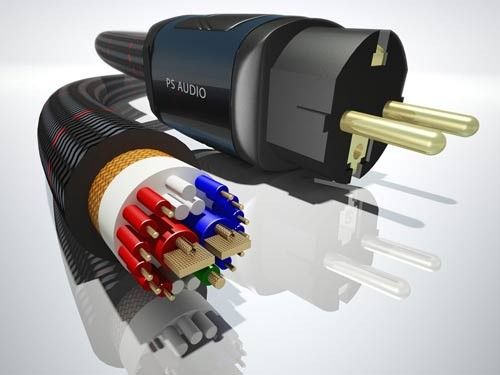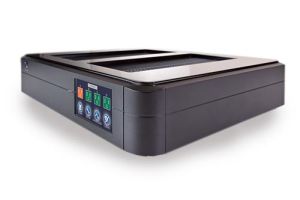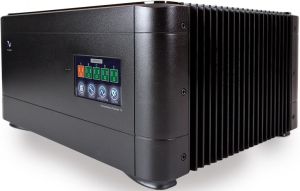PS Audio The PerfectWave AC5 Power Cable
Cable de corriente PS Audio The PerfectWave AC-5
PEDIDO CONDICIONADO A CONSULTAR PRECIO Y PLAZO
Todas las series Perfectwave de PS Audio han sido diseñadas para ofrecer una conexión a la red eléctrica, mucho más rápida, silenciosa y precisa con la que poder conectar todos nuestros equipos, ya sean de estéreo o home cinema: Puro cobre OFC, AWG 10, conectores súper sólidos, cable multi apantallado, secciones de hilado, diferentes, combinadas para mejorar la respuesta en todo el rango de frecuencias y un largo etc de alardes tecnológicos, hacen de estos cables una auténtica maravilla de la conexión.
The design of the AC Series
The performance goals for the AC Series focused on creating a perfectly balanced power cable. Each of the 4 models would incorporate the same construction geometry blended in such a way that the limitations of each model would not upset the delicate balance we were looking for. T
Balance in a power cable is achieved by first fully understanding the major variables that affect perceived frequency balance in the system and then blending by ear the proper combination of these variables to achieve the desired sound.
Breaking the variables into separate groups was the first step in our design. Our experience has shown us that we can achieve a remarkably balanced and seamless power delivery system by breaking the conductor geometry into three groups:
Bass
Midrange
Treble
In previous generations of AC power cables, the PS Audio designers relied on varying the wire gauges to perfect the performance of each of the three groups. What we discovered during the early days of our work is that using multiple gauges of wire is effective but leaves much to be desired.
Bass was never really an issue. The problems came from the midrange and treble regions, with the midrange being the most problematic.
We know that large gauge conductors work well for bass and small gauge cables work best for the treble. So common sense would then suggest that medium gauge wires would work perfectly for the midrange or middle frequencies because of the increased surface area and core material. Our work has shown that while this is in fact true, we were never able to get just the right amount of surface area and core size to achieve what we wanted in the midrange. What we needed was more surface area than core size, but to achieve that the classic ratio found in a round diameter conductor would have to be manipulated. Unfortunately, this is impossible in a round conductor.
In a round conductor, the core size and surface area scale proportionally in a fixed ratio as the diameter changes. It was obvious to our designers that if we wanted an asymmetrical ratio of surface area and core size to play with, we would have to look elsewhere for our solution. We first tried bundling smaller gauge and medium gauge wires together to increase surface area. This worked, but not very well.
We then found a solution in patent 6,969,805 of the US patent office and licensed the patent for our use.
The patent described an elegant solution to the midrange problem: a rectangular conductor.
Imagine a round conductor. Its outer diameter (surface area) is a fixed ratio with the inner diameter (core of the conductor). Any change in either effects the other in a predictably symmetrical fashion. Now imagine taking that same round conductor and flattening it into a thin sheet or rectangle. The amount of surface area has now increased dramatically, while the overall gauge or amount of material remains identical. Essentially, what you now have is a fixed core size with a variable surface area and this was exactly what our engineering team was looking for. We could now control the exact amount of skin effect we needed without changing the core of the conductor. All we had to do was flatten the round conductor as much or as little as our design dictated to achieve the perfect blend of surface area to conductor core.
The results were spectacular. The midrange performance of connected equipment had a bloom and openness that we had never experienced in all our years of building high-end power cables. Truly, this was the major breakthrough in these exceptional cables; midrange performance was better than anything we had ever experienced before.
Trouble with treble
The next problem was even more difficult. The treble (high frequency) conductors had the same requirements as the midrange only magnified. Here we wanted almost no core and all surface area and because of construction requirements we wanted multiple treble conductors to be insulated. To handle this and then bundle the group we would need to have a round cable. How do we then get the increased surface area of a flat cable as well as reducing the core? That was a big problem but we solved it using a variation on the midrange solution.
First we would create a very thin flat rectangular conductor which maximized the surface area and focused the power on the skin of the conductor. Next, we formed the flat conductor into a hollow spiral tube and then extruded a PE foam jacket around the conductor and bundled multiple strands together to form the treble conductor.
The use of PE foam around these conductors was very important. PE foam has a relatively high dielectric constant (compared to air) which means it will constrain the electric field close to the conductor itself. By constraining the electric field the energy of this conductor is held closely and will lower the chances of interfering with the other conductors and fields. Over the years we have found that this results in a very open sounding presentation, especially in higher order musical harmonics like those produced by a piano or acoustic guitar.
Using these techniques and this unique geometry we then proceeded to design the conductor configuration for each of the 4 cables in the line. We could now vary the wire gauges, the skin effect and core sizes for the midrange and the surface area for the treble to achieve the perfect blended and balanced cable within each of the constraints of all 4 models.
Shielding
Shielding a cable means that you place conductors around the entire cable to pickup any electrical noise from within the power cable or from the outside of the cable and carry the noise off to ground. This is important because the equipment you are connecting to generates noise on the power line which is injurious to surrounding equipment as well as keeping extraneous noise from getting into the power cable. Good shielding is a requirement for any power cable in a high-end system.
The design philosophy, with respect to shielding, in the AC Series can be summed up in one word: quiet.
We have found over the years that good shielding means a quiet presentation without an overriding bright “hash” accompanying each note of the music. By eliminating internal and external noise through well shielded power cables, connected equipment is remarkably free from the bright hardness associated with most power cables and delivery systems. This phenomena is not readily apparent until you listen to a component with and without this noise. A high-end system powered through well shielded cables, vs. the same system with poorly shielded cables is remarkably easy to identify with a short listening session.
In the PerfectWave AC Series, we do not rely on a single shield as found in most power cables. In fact, we use a double shield in the AC3, AC5 and AC10, with a quad shield in the AC12. This extraordinary level of shielding raises the performance of connected equipment up to perfection levels.
Conductor materials
In the PS PerfectWave AC Series, the top two power cable modes, AC-12 and AC-10 are built with the purest copper in the world, single crystal PCOCC.
PCOCC is one of the more remarkable manmade metals in the world. It is formed as one single long grain or crystal that runs the entire length of the conductor. It is formed by a process known as The Ohno Continuous Casting Method where molten copper is forced out of the mold and very slowly draws the grain down the conductor’s length, creating a ‘single grain structure’.
There’s only one machine in the world that creates PCOCC single crystal copper and is one of the reasons it is nearly ten times more expensive than OFC. PS has secured a scheduled allotment of the material to build a limited number per month of the AC-10 and AC-12.
The AC-3 and AC-5 Series of PerfectWave cables are built with extremely pure oxygen free copper.
Conductor directionality
Over the years we have come to agree with a select few cable manufacturers that believe conductor direction is critical to high-performance. The direction each conductor is pulled out of the wire machine determines how it will sound when built into a power or audio cable.
Tremendous debate has taken place over these phenomena but from our perspective there can be no doubt about their existence. It did not take multiple listening tests to verify that a spool of wire sounds different when one end or the other is used as the source. All conductors in the PerfectWave AC Series are spool tested at the factory for directionality and then wound into the power cables in the same direction.
This attention to detail provides a remarkable coherence and special accuracy to the sound of connected equipment powered by a PerfectWave AC cable.
Connectors perfected
As early as 2003 PS Engineering realized that even with the best conductor technology in the world, the connectors could be the limiting factor in building a state-of-the-art power cable.
If you look closely at most power cables, they use relatively poor construction techniques and materials to build their connectors. Pictured here is an example of a high-end hospital grade connector found on a very expensive power cable.
Note the plug prong i s a three-piece affair made from a piece of stamped metal (the IEC is constructed in the same manner). The three parts are the prong, the clamp cover and the screw. The prong and clamp are made from brass and the screw is constructed of steel. Some companies will gold, nickel or Palladium plate these parts to improve their conductivity and enhance their appearance, but in the end, no amount of plating can make up for poor build quality.
The PerfectWave AC Series connectors are built out of a solid block of high copper content brass, and then polished to remove any surface irregularities. The AC-10 and AC-12 are gold plated, the AC-3 and AC-5 are nickel plated and polished.
| Conectores | Macho y Hembra estándar español |
|---|---|
| version | Cable de red |




